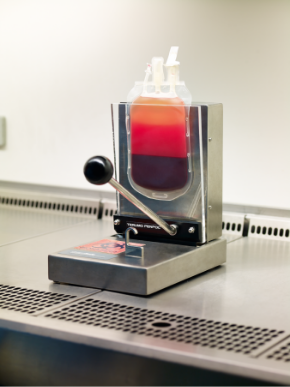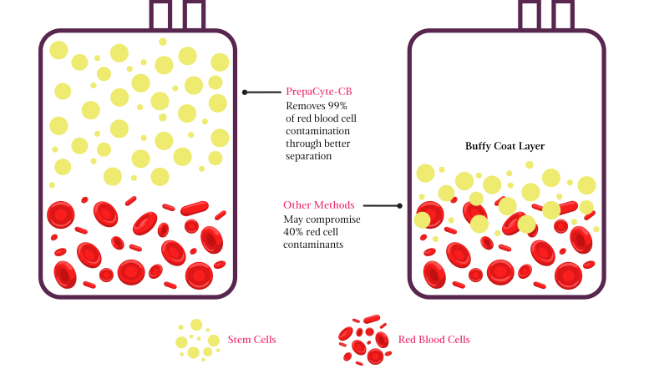


Think “stem cell banking” and what comes to your mind? Now, before you start looking up on the search engine, let’s help you out. Stem cells are the body’s building blocks from which other cells with specialized functions are born. They have the ability to regenerate into different types of specialized cells like brain cells, muscle cells, blood, etc, and are, therefore, used to treat various diseases, including blood cancers. One of the richest sources of these precious stem cells is umbilical cord blood.
The umbilical cord connects the fetus to the mother during pregnancy and is clamped and cut immediately after delivery. At this point, the cord blood containing precious stem cells is drawn in a sample collection bag through a painless process. However, do you know what happens after the sample is collected and reaches the lab? What is cord blood processing and the technology that goes behind it? Let’s explore the answers to all such questions and more..
What Is Umbilical Cord Blood Processing Procedure?
After collection, the umbilical cord blood is transported to the labs for processing. The cord blood is processed to make it ready for cryo-preservation as well as future transplants.
The key aspect of cord blood processing is separation and extraction of high volume of stem cells while also reducing the number of red blood cells and volume of collection. This is because only the stem cells in the cord blood are useful, but not the red blood cells. The red blood cells, on the contrary, can cause complications during future treatments.
The cord blood is first separated weight-wise into 3 layers during processing3:
1. The heaviest layer are red blood cells (RBC)
2. The lightest is the plasma layer
3. The middle layer is called the buffy coat layer that consists of stem cells and white blood cells


It is the buffy coat layer that is eventually considered the final separated component and goes into storage.
The type of technology used for cord blood processing plays a vital role in better separation of the cord blood into the three parts. This, in turn, allows for easier extraction of more stem cells. The cord blood processing technology has a huge impact on the quality of the collection, which can ultimately affect the outcome when used in a transplantation.
LifeCell’s premier cord blood processing technology - PrepaCyte-CB® - helps in extracting the maximum number of viable stem cells from the sample while reducing the RBC contamination up to 99%. Let us learn more about the advantages that PrepaCyte-CB® offers.
1) Higher Stem Cell Recovery2
PrepaCyte-CB® recovers significantly more viable stem cells than the processing methods used by other cord blood banks. In a study that compared Prepacyte-CB with the widely used Hetastarch process, the number of hematopoietic stem cells recovered through Prepacyte-CB process was 11.81% more than Hetastarch. Additionally, following the freeze–thaw process, PrepaCyte‐CB‐processed samples contained on average more stem cells than those obtained after processing using Hetastarch.
2) Lower Red Blood Cells1(see reference below)
PrepaCyte-CB® also reduces red blood cell (RBC) contamination. Fewer red blood cells post-processing means fewer toxic side elements. AutoExpress (AXP) can reduce the red cell count by up to 70% and Sepax can reduce its RBCs by 84%; however, PrepaCyte-CB® can get rid of up to 99% of red blood cell contamination.


3) Faster Recovery After Transplants1(see reference below)
Most importantly, PrepaCyte-CB® processed cord blood expedites the recovery post transplants. Earlier engraftment time means the patient will spend less time in the hospital during a vital stage when they don’t have a robust immune system capable of fighting pathogens.
| Parameters | Prepacyte aCB | SEPAX/SEPAX2 | AXP/AXPII |
|---|---|---|---|
| Days to Recovery of Patient | 16 Days | 21 Days | 21 Days |
| TNCC Recovery (%) | 85 - 90% | 75 - 80% | 76% |
| RBC Depletion (%) | 99% | 84.70% | 70% |
4) Saves Hospitalization Cost
A comparison between the engraftment time (days to recovery) for transplants with PrepaCyte-CB® processed cord blood to other methods, shows the superiority of the method (depicted in the table above). Faster recovery leads to less time in hospital which ultimately saves money!
PrepaCyte-CB® - Edging Out Competition
Here’s what helps PrepaCyte-CB to edge out competition - one at a time!
- Maintains the viability of stem cells2
- Fast, reliable separation with improved recovery of nucleated cells4
- Stem cell recovery remains constant regardless of volume of the collected sample4
- Being a closed system, Prepacyte-CB reduces the risk of contamination4
To Sum It Up
The technology used for cord blood processing is not often discussed in detail, although it is important. As parents, you may get confused with the term ‘processing’, especially if it is used as a general description for everything that goes on in a laboratory once the sample arrives.
Therefore, it is a good idea for you to understand the aspects of cord blood processing technology. The best technology is the one that ensures maximum extraction of stem cells while reducing red blood cell contamination for up to 99%. For this, you can rely on the premier cord blood processing technology - PrepaCyte-CB®. Fortunately, LifeCell is the only organization in India that uses this technology.
Umme Sadiya Qamar
Sadiya comes with nearly a decade of experience in Biopharma data handling. She even specialized as a Lab Data SME (Subject Matter Expert) during her tenure with a leading MNC. After a brief overseas stint (UAE), she worked as an editor with a reputed pregnancy & parenting website - an experience she counts on in dealing with her own day-to-day parenting challenges. At LifeCell, she continues to proactively be a part of various product strategies and content creation processes.


Track your
breast milk with




